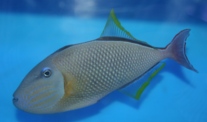Jason here. Working at That Fish Place, I have many people ask me about bottom feeders that they can put into a tank with their African Cichlids. Since cichlids tend to be aggressive, it can be difficult to find suitable tankmates. A great solution to this problem is adding a Synodontis catfish species.
There are many species of Synodontis that grow to various sizes. Synodontis are great because they are often found in many of the same locations as the cichlids. One of my personal favorites is Synodontis petricola, often referred to as Pygmy Synodontis among hobbyists. They are a relatively small, in comparison to the other members of the genus, maxing out at around five inches. This catfish is native to Lake Tanganyika, in Africa, which is part of the group of lakes commonly referred to as the African Rift Lakes and has a pH ranging from 7.0-8.5. Their coloration is usually brown with black spots. Their fins are black with highly defined white trim. Dietary choices consist mostly of meaty foods, but they will also pick at algae from time to time.
Another excellent choice for those with an Afican cichlid tank is Synodontis multipunctata, also from Lake Tanganyika. In their natural environment, their preferred pH ranges from 7.8 – 8.5. They have a similar appearance to the Pygmy Synodontis, only with less defined white trim on the fins and a larger max size, as in the aquarium they grow to approximately 8 inches in length. They prefer tanks with a lot of dark places to hide out. Like the petricola, they are omnivorous and are known to pick at algae along with their main diet of meaty foods. They can usually be found under the common name Cuckoo Synodontis, though petricola also shares that common name.
Our most commonly sold Synodontis is a tropical species that tends to swim upside down. It gets its common name, Upside-Down Synodontis Catfish because of this odd style of swimming. Its scientific name is Synodontis nigriventris. Unlike the prior two catfish noted, this one won’t do as well in with the African Cichlids, but makes an excellent addition to tanks with a lower pH, ranging from 6.0 – 7.5. Full grown they will only reach about 4 inches, and they are active and interesting to observe. They can be kept with most tropical fish, but they have been known to cause some problems with the smaller tetras.
There are many other many possibilities, when looking for an interesting bottom dwelling species to add to your home aquarium. There are many different colors and sizes. Come in to see us or drop us an e-mail at Marinebio@thatpetplace.com if you need any help or advice in choosing a species.
 On the salty side you’ll find our biggest excitement for the week, a male Crosshatch Trigger. He’s big, bold and beautiful. We also got a lovely little Yellow Assessor, who’s not to shy and would look terrific in someone’s reef! Other items of note are a small Watanabei Angel and two new damsels, Limbaugh’s and some big Scissortail Chromis.
On the salty side you’ll find our biggest excitement for the week, a male Crosshatch Trigger. He’s big, bold and beautiful. We also got a lovely little Yellow Assessor, who’s not to shy and would look terrific in someone’s reef! Other items of note are a small Watanabei Angel and two new damsels, Limbaugh’s and some big Scissortail Chromis. Not too much fresh on the freshwater end this week, but there are the Swamp Eels that might be very interesting in the right tank. Also some nice looking Albino Butterfly Bristlenose Plecos. There are also some other fish for communities that don’t come around too often including Inky Barbs, Burma Danios, and Empire Gudgeons.
Not too much fresh on the freshwater end this week, but there are the Swamp Eels that might be very interesting in the right tank. Also some nice looking Albino Butterfly Bristlenose Plecos. There are also some other fish for communities that don’t come around too often including Inky Barbs, Burma Danios, and Empire Gudgeons. That Fish Blog – Aquarium Advice and Information
That Fish Blog – Aquarium Advice and Information

 Also known as the Tailbar Cichlid, this particular species hails from the rivers of Central America. It frequents areas of still or slow moving waters , hiding amongst root tangles. An uncommon fish in the hobby, we have been carrying 2″ juveniles for a little while now, along with a beautiful 6″ male in a separate aquarium that also arrived.
Also known as the Tailbar Cichlid, this particular species hails from the rivers of Central America. It frequents areas of still or slow moving waters , hiding amongst root tangles. An uncommon fish in the hobby, we have been carrying 2″ juveniles for a little while now, along with a beautiful 6″ male in a separate aquarium that also arrived.



